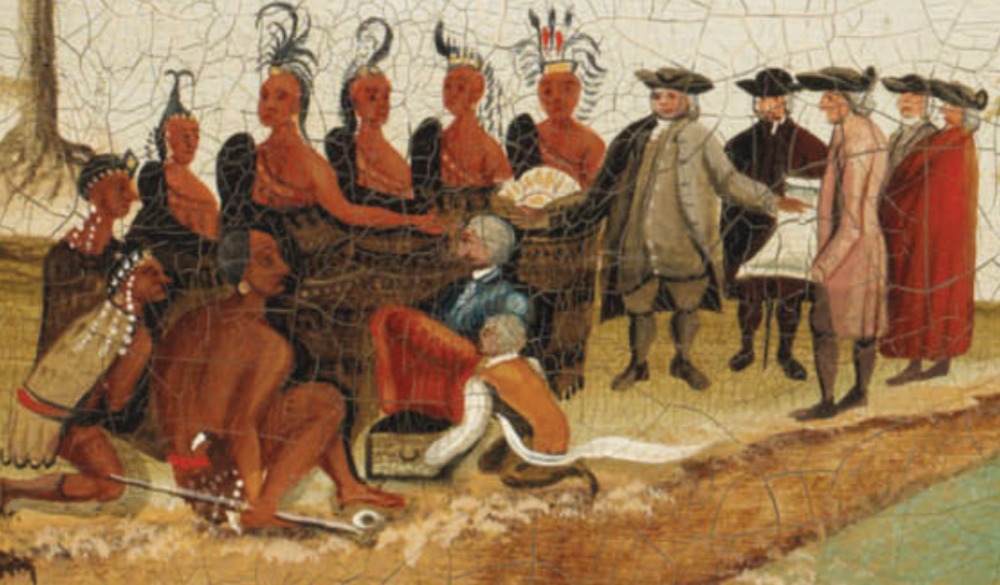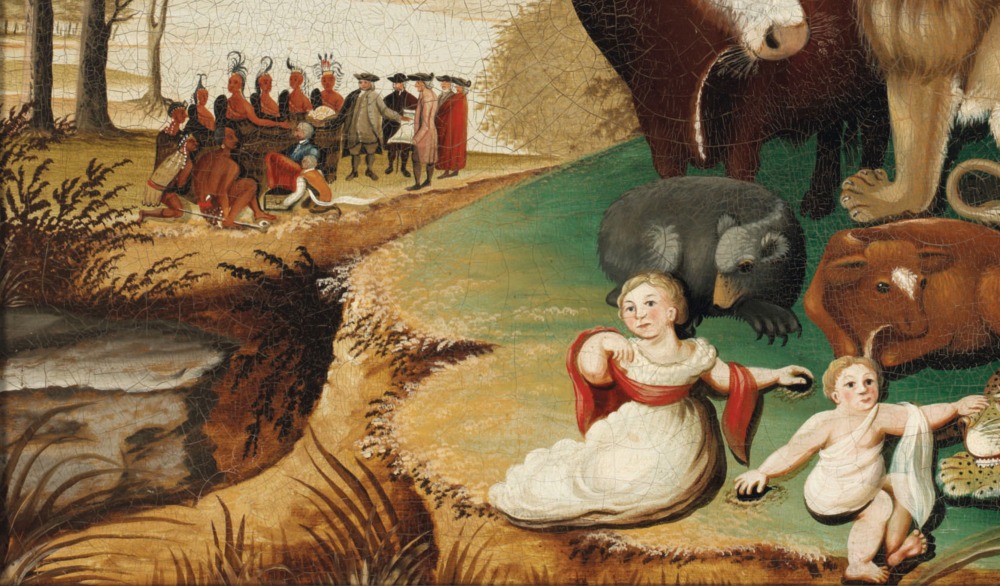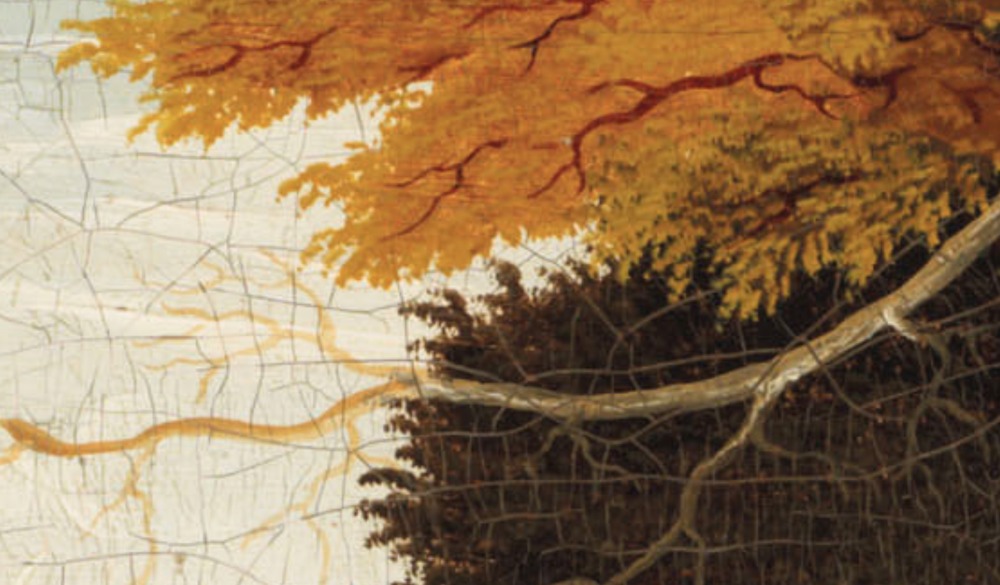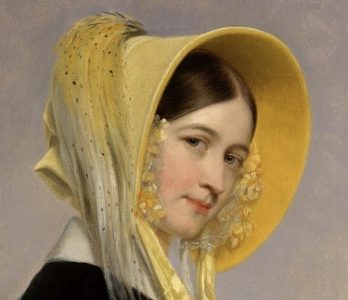Note: Image galleries do not display properly in WordPress Reader. Best Viewed At Sunnyside.
![screenshot_2019-01-13 2019_nyr_16796_1209_000(edward_hicks_peaceable_kingdom) jpg (jpeg image, 3200 × 2511 pixels) - scaled[...]](https://atsunnyside.blog/wp-content/uploads/2019/01/screenshot_2019-01-13-2019_nyr_16796_1209_000edward_hicks_peaceable_kingdom-jpg-jpeg-image-3200-×-2511-pixels-scaled....jpg?w=1000)
Isaiah 11:6-9
The wolf shall dwell with the lamb, and the leopard shall lie down with the young goat, and the calf and the lion and the fattened calf together; and a little child shall lead them. The cow and the bear shall graze; their young shall lie down together; and the lion shall eat straw like the ox. The nursing child shall play over the hole of the cobra, and the weaned child shall put his hand on the adder’s den. They shall not hurt or destroy in all my holy mountain; for the earth shall be full of the knowledge of the Lord as the waters cover the sea.

Peaceable Kingdom
Edward Hicks (1780 – 1849) was an American folk painter and distinguished minister of the Society of Friends (aka “Quakers”). He became a Quaker icon because of his paintings, though Hicks was better known as a minister than as a painter during his lifetime.[10]
Around 1820, Edward Hicks made the first of sixty-two paintings of The Peaceable Kingdom. According to Christie’s, the current version is “fully developed and optimistic” and “a particularly powerful rendition of Edward Hicks’ famous series.”
Christie’s continues:
“Hicks’ repetition of the same scene was a deeply personal undertaking, almost an act of faith, rather than a source of income and as such, the variations seen among these iconic works reflect the changing state of Hicks’ world, his Quaker community and his own mind.” Christie’s
Compare Peaceable Kingdoms: c.1826 – c.1840
Compare: The Peaceable Kingdom (1826), Peaceable Kingdom with Quakers Bearing Banners (1829–30), Peaceable Kingdom (1833), The Peaceable Kingdom (1940s).
Click to Enlarge Detail
What differences do you see?
“…the variations seen among these iconic works
reflect the changing state of Hicks’ world,
his Quaker community and his own mind.”
Middle Kingdom – Prophecy Fulfilled
Quaker beliefs prohibited a lavish life or emphasis on material possessions. Unable to maintain his work as a preacher and painter at the same time, Hicks transitioned into a life of painting, and he used his canvases to convey his beliefs.
As Christie’s explains, “This canvas exemplifies Hicks’ Middle Kingdom works from the 1830s, after the more tentative early years, before the weariness of his old age, and when hope reigned supreme.” Although it is not considered by some to be a religious image, Hicks’ Peaceable Kingdom exemplifies Quaker ideals.
For example, both the animals and the children are patterned after Isaiah 11:6–8 (also echoed in Isaiah 65:25). The quest for peace among all and the redemption of souls are both part of Edward Hicks’ theological beliefs.[12] He was unconfined by rules of his congregation and able to freely express what religion could not: the human conception of faith.[11] Christie’s describes the result:
Sanguine and abundant, the animals in this work evoke a positive world, one where the prophecy of Isaiah (see above) has come to pass and traditional foes have put aside their differences to live in harmony…. Here, Hicks has found a successful, balanced composition that evokes this outlook. Christie’s

William Penn’s Peace Treaty 1683
Many of Hick’s paintings further exemplify this concept of reconciliation by including depictions of Native Americans meeting William Penn and the settlers of Pennsylvania. See Edward Hick’s: Penn’s Treaty With the Indians (c.1830) .
Hicks admired Penn for two reasons:
- Hicks admired Penn as an opponent of British power in America, and he hoped that Penn could help ensure reform.
- Hicks admired Penn’s treaty between Pennsylvania and Native Americans.
According to Christie’s, “In 1683, William Penn negotiated a peace treaty with the local Lenape tribes people and as a demonstrable instance of peace and harmony, this historical subject struck at the core of Hicks’ beliefs.” Hick’s choice to feature this group in the background “further balances the composition.” of Peaceable Kingdom (1833).
Schism Becomes Chasm
During the 1820s, a severe rift formed within the Society of Friends. In 1827 a schism formed between Hicksites (named after Edward Hicks’ cousin Elias Hicks) and Orthodox Friends.[8] As the Pennsylvania’s Quaker community grew, many small groups branched off into sects with conflicting beliefs, which greatly discouraged Edward Hicks from continuing to preach.[9] Nonetheless, in his lifetime Hicks was better known as a minister than as a painter.[10]

In our 1833 version of Hicks’s Peaceable Kingdom, the split is represented by the deep chasm separating the two main parts of the composition. Christie’s explains further:
This event is also placed on ground that is separated by a chasm-like divide from the foreground with the animals. Such a visual break in the overall picture probably refers to discord between the Hicksite and Orthodox Quakers, a conflict that culminated in the great schism of 1827. Christie’s. (emphasis added)
Likewise, Hicks’ desire for peace between the factions is represented by the “menagerie of discordant beasts lying down in perfect harmony.” To Edward Hicks, the lion and his companion, the ox, were symbols of redemption.
To Edward Hicks, the lion and his companion,
the ox, were symbols of redemption.
Video: New World Proverb
Value of Family and Motherhood
The presence of a female lion, which appears in most Middle Kingdom iterations, has been associated with Hicks’ concern with family and motherhood. Hicks’ own mother died when he was only one year old, an event that would have had a profound effect throughout his whole life. Furthermore, women were afforded significant status within the Quaker ministry, so the inclusion of this second lion reveals the priorities of his immediate community. Christie’s
According to Christie’s, “In articulating his religious and personal beliefs through the strokes of his paintbrush, Hicks created a masterful body of works that attest to his enduring legacy.”
“…a little child shall lead them…”
Click For Enlarged Detail
In Summary
Few American artists are as beloved as Hicks, a devout Pennsylvania Quaker preacher and painter whose fascination with the religious theme of the peaceable kingdom constitutes one of the most popular and complex stories in American art. Toylike animals; placid landscape scenes, mostly of the Delaware Water Gap; and renditions of Penn’s treaty consistently populate Hicks’s kingdoms—so peaceable in their ideal of universal harmony, yet weighted with national and religious concerns of the time. Naively and at times crudely painted, Hicks’s canvases nonetheless radiate passion and charm, and their underlying sources and motivations suggest a rare complexity in the field of so-called American “folk art.” Google Arts and Culture
“In articulating his religious and personal beliefs
through the strokes of his paintbrush,
Hicks created a masterful body of works
that attest to his enduring legacy.”

Details
- Edward Hicks (1780-1849)
- Peaceable Kingdom (1833)
- in the original black painted and gilded pine frame; the reverse with label with transcription of Isaiah 11:6-9
- oil on canvas
- 17 ½ x 23 ½ in.
- Painted circa 1833
- Source: Christie’s
- Link: https://www.christies.com/lotfinder/paintings/edward-hicks-peaceable-kingdom-6188121-details.aspx?from=searchresults&intObjectID=6188121&sid=
Sources
- Christie’s, Sale 16796, “Edward Hicks, Peaceable Kingdom, 1833,” Important American Furniture, Folk Art, Silver and Prints, New York, 17 – 18 January 2019, https://www.christies.com/lotfinder/paintings/edward-hicks-peaceable-kingdom-6188121-details.aspx?from=searchresults&intObjectID=6188121&sid= (accessed 13 Jan 2019).
- Wikipedia contributors, “Edward Hicks,” Wikipedia, The Free Encyclopedia, https://en.wikipedia.org/w/index.php?title=Edward_Hicks&oldid=877901995 (accessed January 13, 2019).
- Google Arts and Culture, Edward Hicks, Peaceable Kingdom 1826-1828, https://artsandculture.google.com/asset/dgFcHUr2Xd1dJA (accessed 13 Jan 2019).
- Wikimedia Commons contributors, “File:Edward Hicks – The Peaceable Kingdom – Google Art Project (723124).jpg,” Wikimedia Commons, the free media repository, https://commons.wikimedia.org/w/index.php?title=File:Edward_Hicks_-_The_Peaceable_Kingdom_-_Google_Art_Project_(723124).jpg&oldid=174620008 (accessed January 14, 2019).
Read More
Thanks for Reading! 🙂
~Sunnyside




The only way to true peace on earth is through the Prince Of Peace.
LikeLiked by 2 people
🙏❤️🙏
LikeLiked by 1 person
Thanks for your excellent introduction to the life and work of Edward Hicks.
LikeLiked by 1 person
My pleasure, Rosaliene! I appreciate your encouragement. 🙂
LikeLiked by 1 person
I adore this painting!
LikeLiked by 1 person
Hi Wendi! – thanks so much for visiting! 🙂
LikeLiked by 1 person
bless you!
LikeLiked by 1 person
❤️🙏
LikeLiked by 1 person